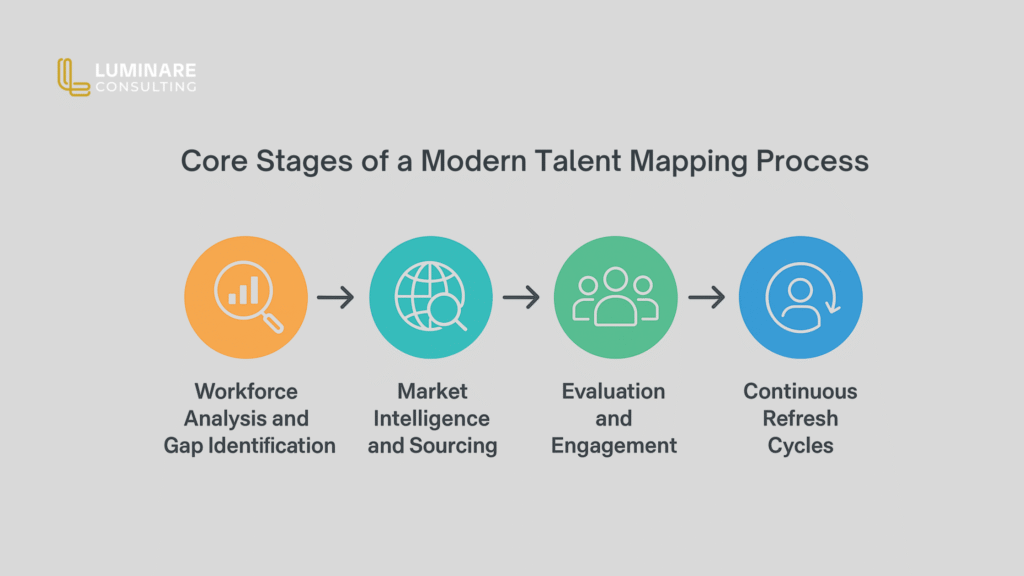
Finding the right leader for a critical role in today’s market can feel like an impossible task. You’ve likely seen the same limited pool of candidates, faced sky-high salary expectations, and watched key positions sit vacant for months, slowing your company’s growth.
What if I told you the traditional recruitment process is the problem? Relying on active job seekers for your most important hires means you're only seeing a fraction of the available talent. From my experience closing complex searches, the breakthrough comes when we shift from reactively filling a role to proactively mapping the entire talent ecosystem.
This strategic approach is the core of a robust talent mapping process.

Key Takeaways:
Think of it this way, the traditional recruitment process is often reactive. A role opens, a job description is posted, and you hope the right candidates apply.
In today’s market, this isn’t enough. An effective talent mapping strategy transforms your talent acquisition from a reactive function to a proactive, strategic powerhouse.
The talent mapping process creates a dynamic, intelligence-driven framework for understanding the entire talent landscape for your critical roles. Many HR leaders confuse talent mapping with succession planning. While they're related, succession planning is internally focused on developing existing employees for future key positions.
Talent mapping is an external and internal intelligence mission. It helps you proactively identify and engage with high-potential individuals, building a robust talent pipeline before you even have a vacancy.
For hiring managers and HR leaders, the goal is to align the mapping process directly with the long-term business strategy. This means understanding not just the key skills needed today, but the competencies and leadership qualities required to meet future needs.
By focusing on your most critical roles first, you can ensure your resource allocation is targeted and effective, building a foundation to meet future talent needs with precision.
Read More: Understanding Talent Mapping and Its Impact on HR Strategy in 2025
The executive talent shortage is no longer a distant threat; it’s a present-day reality, especially in the competitive Indonesian market. What I've learned from working with Indonesian market leaders is that relying on active job seekers for key leadership positions can lead to long, costly vacancies. Leadership agility is a board-level priority, and a strategic talent mapping process is your best hedge against the risks of an empty executive chair.
A study in the International Journal of Innovation Management and Organizational Behavior (2024) reinforces this, highlighting that a structured approach to identifying key roles and building a talent pool are critical indicators of effective talent management.
A key reason why talent mapping is important is its ability to give you a competitive edge in a tight labor market. The current talent market is candidate-driven, and top-tier candidates are often passive candidates, they are not actively looking for new opportunities but are open to the right one.
A proactive approach through talent mapping allows you to build relationships with these individuals long before they enter the job market.
Our engagement with a multinational data research solution company perfectly illustrates how talent mapping transforms recruitment in highly specialized markets. The company needed a Business Development Manager with direct industry experience—a seemingly impossible task given Indonesia's limited data research talent pool.
The traditional approach would have failed immediately. Most direct competitors operated their APAC offices from Singapore, not Indonesia, making local senior sales talent extremely scarce. Instead of accepting these limitations, we executed a comprehensive competitor and talent mapping strategy that went beyond geographical boundaries.
By systematically mapping the entire competitive landscape and identifying key sales professionals across the region, we uncovered a talent ecosystem that our client had never accessed. This strategic intelligence approach not only identified the perfect candidate from a direct competitor but also provided valuable market insights on remuneration benchmarks and industry practices.
The result was a successful placement that brought immediate market credibility and an established client database—proving that even in the most niche markets, a strategic mapping approach can unlock hidden talent pools and deliver exceptional outcomes.

An effective mapping process is systematic and continuous. It’s not a one-off project but an ongoing cycle of intelligence gathering and relationship building to find the most suitable candidates.
Start by looking inward. What are the key positions vital to your business strategy? Where are the potential skill gaps in your current workforce? This stage involves deep conversations with hiring managers to understand the job requirements for today and the skill sets needed for tomorrow. We proactively identify skill gaps before they become urgent problems.
This is where we move beyond the obvious to identify potential candidates. We map out competitors and complementary industries to build a rich talent pool. This stage involves collecting data, understanding career paths, and discreetly gathering valuable insights about the market. The data collected helps create a living map of talent, including those highly valuable passive candidates.
Once potential candidates are identified, the next step is to evaluate them against a framework that measures both competency and cultural fit, including essential soft skills. We then begin building relationships, creating a network of qualified candidates who view us as a trusted partner in their career aspirations.
The talent market is not static. An effective talent mapping process requires continuous refresh cycles to keep your intelligence current. According to a study on empowering human resources, this strategic process is crucial for enabling a company to remain agile and develop sustainably in a competitive environment (Rony et al., 2021).
Also Read: Talent Acquisition vs Talent Mapping Choosing the Right Strategy for Future-Ready Teams
The real value of talent mapping shows up in measurable business outcomes. The benefits of talent mapping extend far beyond just filling roles faster; they impact everything from your budget to your brand.
A well-executed talent mapping strategy significantly reduces time to hire. Because you have a pre-vetted talent pipeline of qualified candidates, your recruitment process can move much more quickly when a new role opens.
This proactive approach also enhances your employer branding, as you are building long-term relationships within your industry. Potential candidates see your organization as a place that plans for the future, making you an employer of choice.
When a leading F&B lifestyle group approached us, their Marketing Director role had been open for over a year after multiple agencies had failed. The standard hiring process wasn't working. By conducting a deep market mapping process, we identified leaders in non-obvious industries who possessed the core leadership qualities the client needed.
This strategic approach not only filled the role within six months but also transformed our relationship. We became a trusted partner, and our work demonstrated how talent mapping offers valuable insights that lead to better hiring decisions and secure a long-term competitive edge.
Succession planning primarily focuses on identifying and developing internal, existing employees to fill future leadership roles. Talent mapping is a broader, more strategic process that includes both your current workforce and external talent, creating a comprehensive map of potential candidates in the wider market to fill critical roles and address skill gaps.
A targeted talent mapping project for a specific key role can take anywhere from four to eight weeks to build the initial comprehensive talent map. However, the most effective talent mapping is an ongoing strategic process, with continuous refresh cycles to ensure the data remains current and valuable for future hiring.
Begin by focusing on one or two mission-critical roles that have the biggest impact on your business strategy. Work closely with the hiring managers for these key positions to define the ideal candidate profile and identify key competitors. This focused, proactive approach will demonstrate the value of talent mapping and help build the case for expanding the strategy.
You Might Also Like: How a Strong Leadership Pipeline Transforms Executive Hiring Strategies

